Clash of Titans
Games featuring a future Hall of Fame coach on each sideline.
November 1, 1913: Notre Dame @ Army
Jesse Harper vs Charles Daly
Dorais to Rockne Revolutionizes Football
The college passing game was greatly enhanced by rules changes enacted before the 1912 season.
-- The 20-yard limit on a forward pass was eliminated.
-- A 10-yard "end zone" was added to each end of the field.
-- A ball caught in the end zone was a touchdown. (Previously forward passes across the goal line were illegal.)
-- The size, weight, and shape of the football was standardized. The more elongated, less circular shape made the ball easier to grip. As a result, passers were able to throw spirals further and more accurately.
-- A 10-yard "end zone" was added to each end of the field.
-- A ball caught in the end zone was a touchdown. (Previously forward passes across the goal line were illegal.)
-- The size, weight, and shape of the football was standardized. The more elongated, less circular shape made the ball easier to grip. As a result, passers were able to throw spirals further and more accurately.
Jesse Harper, who replaced John Marks as Notre Dame head coach in 1913, was already an afficionado of the forward pass at Alma and Wabash colleges following its legalization in 1906. But by 1913, only Amos Alonzo Stagg at Chicago, Fielding Yost at Michigan, and Dan McGuigan at Vanderbilt were using the forward pass effectively, and none of those schools were in the Northeast. Harvard, Yale, Princeton, and other top-notch Eastern teams, including Army and Navy, used the pass only on rare occasions as a play of last resort.
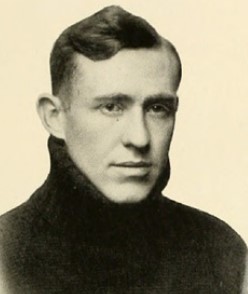
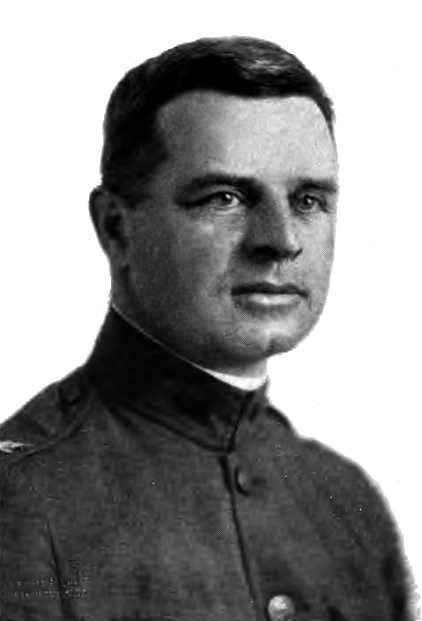
L: Notre Dame Coach Jesse Harper; R: Army Coach Charles Dudley Daly
The Notre Dame football program stood at a crossroads after the 1912 season. While the school had gone 13-0-2 the previous two seasons, the program lost money both seasons to the tune of $2,300 and $500. A major reason for the deficits was the fact that members of the Western Conference (today's Big Ten) refused to play Notre Dame, forcing the Catholic college to play smaller schools that did not have large followings. The reason given by Michigan and other Western Conference schools was that Notre Dame used ineligible players even though no proof was ever provided to back up that charge.
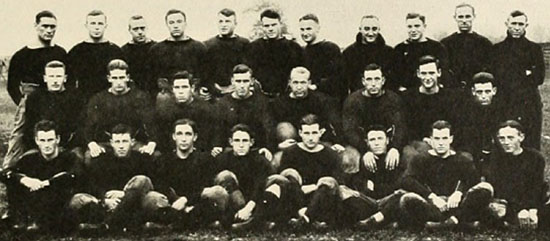
1913 Notre Dame Fighting Irish (University of Notre Dame Dome Yearbook Class of 1914)
Having been hired not only for his coaching skills but also for his financial acumen, Harper immediately set about trying to upgrade Notre Dame's schedule. In the spring of 1913, Jesse sent out letters to numerous colleges asking for football games for the upcoming season. He received positive responses from Penn State and Texas as well as from smaller schools.
But the school that eventually filled the spot on the Harper's schedule was one who wrote to him — West Point. The Cadets' game with Yale scheduled for November 1 was cancelled because it would "take too much out of the boys" before the annual meeting with Navy. Anxious to plug the hole in the schedule, the Cadet Football Manager wrote to a number of schools including Notre Dame, which had recently signed to play West Point in baseball and had an open date on November 1. The manager offered $400 for the football game. Harper negotiated that up to an unheard-of $1,000, pointing out the distance the team would have to travel.
Featured Players
When Jesse Harper took over as Notre Dame football coach in 1913, he quickly realized he had inherited some excellent players. He was particularly struck by a senior end by the name of Knute Rockne. Rockne had become a leader who could inspire his teammates to a performance level above their natural abilities.
Harper considered Rockne's roommate, QB Gus Dorais, one of the finest passers he had ever seen. Gus was also a fast, elusive runner and dangerous kick returner. Dorais had started as signal-caller the two previous years.
Harper realized he had the ideal pitch-and-catch duo that would allow more creativity in the aerial game. Jesse had developed a more effective way to pass and catch the football, which in 1913 was essentially a rugby ball, larger and more round than today's spheroid. Most teams threw their infrequent passes to standing receivers who caught the ball in their midsections. Harper taught his passers to throw overhand and his receivers to catch the ball over the shoulder on the run without breaking stride.
Harper arranged for Rockne and Dorais to work at the Cedar Point Resort on the south shore of Lake Erie during the summer. They spent their spare time at the beach in their bathing suits but not swimming or getting a tan. Instead, they threw and caught the football that Harper had sent with them, rehearsing a variety of pass patterns.
Though only 5'7", Dorais possessed a surprisingly strong arm. Through repetition, he and Rockne developed their individual techniques as well as a symbiotic relationship. Rockne later wrote: "Perfection of the forward pass came to us only through daily, tedious practice. I'd run along the beach, Dorais would throw from all angles. ... I mastered the technique of catching the football with hands relaxed and tried to master the more difficult feat of catching it with one hand."
Dorais recalled: "I worked hard to increase the accuracy and length of my passes. ... Rockne continued to develop his deceptive stop-and-go style of going down the field for a pass, a style used by nearly all good pass receivers." The two returned to Notre Dame in superb physical shape. |
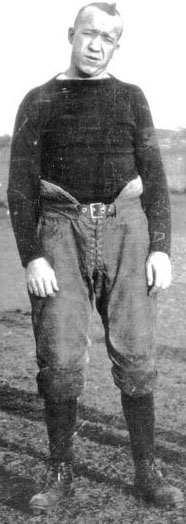 Knute Rockne 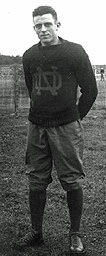 Gus Dorais |
Notre Dame easily won its first three games by a combined score of 169-7. With a new coach of its own, Charles Dudley Daly, Army won its first four games–against tougher opponents than the Fighting Irish–by a combined 72-6.
The Cadets originally considered their first ever meeting with the small Catholic college from Indiana a "breather" but heard reports out of the Midwest that made them take the contest more seriously. Coach Daly brought in extra coaches, alumni of West Point, Harvard, and Michigan, to help prepare the team.
The entire Notre Dame student body gathered early on Thursday, October 30, to send their "band of nineteen gold and blue warriors" on their way. To illustrate the austere circumstances, the traveling team brought only 14 pairs of cleats for the 19 players. Meals on the train consisted of sandwiches packed by the nuns in the college cafeteria. The West Point equipment manager noticed that the visitors were poorly equipped. "I remember being asked by many of the players, who were in the process of dressing before the game, if they could obtain some ankle wraps, knee guards, supporters, extra shoe strings, several pairs of shoes and two extra pairs of football pants."
Army had scouted Notre Dame's 62-0 thrashing of lowly Alma the week before the Irish came to West Point. QB Gus Dorais threw four touchdown passes during the rout. But the Army scouts apparently dismissed the passing success as easy to do against a hopelessly outmanned opponent.
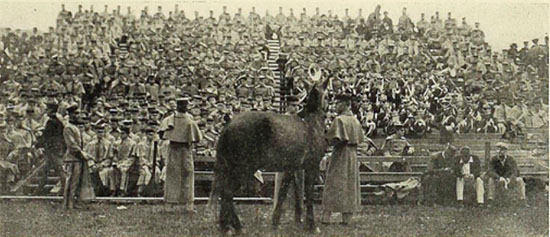
1913 Army Corps of Cadets and Band with the Army Mule (West Point Howitzer Yearbook Class of 1914)
Dorais to Rockne Touchdown!
November 1, 1913, was a cold, raw day at West Point. 3,000 to 5,000 spectators, depending on whose estimate you choose to accept, gathered to watch the Cadets host Notre Dame. With free admission, the crowd consisted almost entirely of cadets and Army fans.
Rockne, as visiting captain, correctly called the toss and elected to receive. 6'4" John McEwan kicked off to Gus Dorais, who took only a few steps before being buried under a pile of Cadets. On the second play, Notre Dame fumbled, and Army recovered. But nothing came of the break as each team was penalized for holding. So Paul Hodgson punted to Dorais on the five, and he wiggled to the 35 before going down.
After Joe Pliska gained five around end, Dorais tried his first forward pass, but it fell incomplete. So Dorais punted to midfield. When Hodgson punted back, Dorais fumbled when tackled hard, and Laurence Meacham fell on the ball for Army. But again, the Cadets could not take advantage.
FB Ray Eichenlaub and HB Charles Finegan tore big holes in Army's front. Dorais tried a second pass, but it too failed. So he went back to the ground game. Eichenlaub and Pliska succeeded in carrying the ball to the 25.
Now came the play that shocked the Army team and their crowd. Dorais dropped back and fired a pass to Rockne, who caught the ball "a few yards from the goal line" (New York Times) and took in for a touchdown. A pass of that length to a receiver on the dead run was unheard of in 1913. Dorais's PAT made it 7-0.
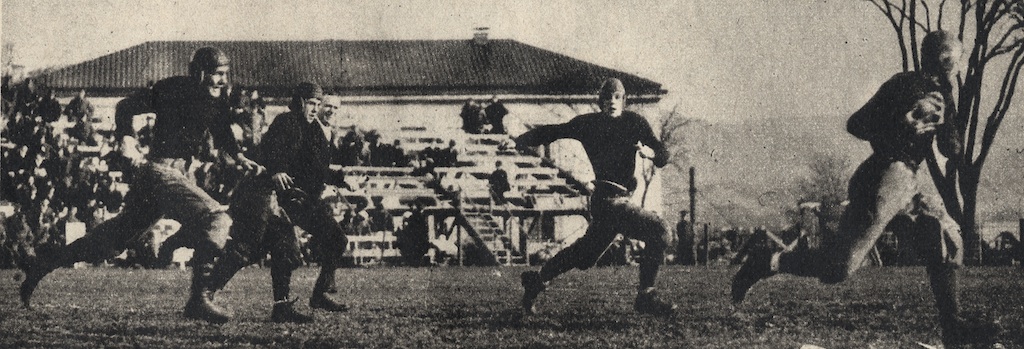 Knute Rockne scores the first touchdown against Army.
Knute Rockne scores the first touchdown against Army. Years later, Rockne recalled the first touchdown against Army. "After one fierce scrimmage, I emerged limping as if hurt. On the next three plays ..., I limped down the field, acting as if the thing farthest from my mind was to receive a forward pass. After the third play, the Army halfback covering me figured I wasn't worth watching. Even as a decoy, he figured I was harmless.
"Finally Dorais called my number, meaning that he was to throw a long forward pass to me as I ran down the field and out toward the sideline. I started limping down the field, and the Army halfback covering me almost yawned in my face, he was that bored. I put on full speed and left him standing there flatfooted. I raced across the Army goal line as Dorais whipped the ball, and the grandstands roared at the completion of a 40-yard pass [actually 25]. Everybody seemed astonished. There had been no hurdling, no tackling, no plunging, no crushing of fiber and sinew. Just a long-distance touchdown by rapid transit."
"Finally Dorais called my number, meaning that he was to throw a long forward pass to me as I ran down the field and out toward the sideline. I started limping down the field, and the Army halfback covering me almost yawned in my face, he was that bored. I put on full speed and left him standing there flatfooted. I raced across the Army goal line as Dorais whipped the ball, and the grandstands roared at the completion of a 40-yard pass [actually 25]. Everybody seemed astonished. There had been no hurdling, no tackling, no plunging, no crushing of fiber and sinew. Just a long-distance touchdown by rapid transit."
Before the period ended, Dorais "got off several spectacular forward passes to Pliska and Rockne." But neither contributed to a touchdown drive. Gus finished the quarter with six completions in a row.
Army Ties the Score
Army tried its hand at passing in the second quarter. Vernon Prichard, Army's quarterback, connected with Lovett to the Notre Dame 15. Hodgson and Leland Hobbs carried the ball the rest of the way, with Hodgson hurling himself over the goal line. Roscoe Woodruff rushed in as a "pinch kicker" and booted the ball over the crossbar to tie the score 7-7.

Woodruff Kicks Goal for Army. (1914 West Point Howitzer Yearbook)
Army Takes the Lead
When the Cadets got the ball back, Rockne tackled E Louis Merillat so hard "that he was laid out, but came back into the game smiling just as soon as he got his wind again. ... Prichard then drove the Army team at top speed, and a fine forward pass, which he threw to [John] Jouett, landed the leather on the five-yard line. Three times Hodgson and Hobbs tried to batter their way over the goal line, but got only as far as the one-yard mark. Here Notre Dame was penalized for holding, and the Army fortunately got a first down. Still, the defense refused to yield. Hodgson slammed into the line twice only to be repelled. Finally, Vernon Prichard hurled himself into the end zone as the crowd "went wild with joy." Benjamin Hoge's kick misfired to leave the score 13-7 Army.
Dorais Passes Set Up Go-Ahead Touchdown
West Point's joy was short-lived. Starting from the 15, ND "sailed serenely" down the field for a touchdown. "Dorais fell back and the Notre Dame team spread out across the field. Dorais hurled the ball high and straight for twenty-five yards, and Rockne, on the dead run, grabbed the ball out of the air and was downed in midfield." Then Gus targeted Pliska. "The ball went high and straight, and Pliska was far out of the Army's reach when he caught it. The partisan Army crowd for the moment forgot that the Army was being defeated, and burst forth in a sincere cheer for the marvelous little quarter back Dorais and his record toss of 35 yards." The next throw went to Charles Finegan who was downed a few yards from the goal. Pliska then went off tackle for the six. Dorais booted the go-ahead point. 14-13 Notre Dame
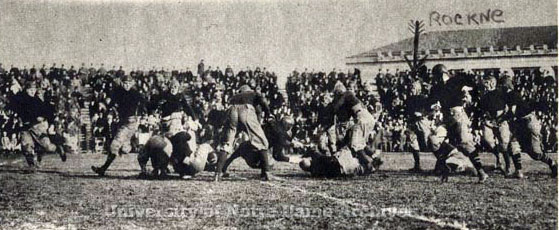
Notre Dame-Army action
Notre Dame almost added another touchdown before halftime. The visitors had the ball at the Army 43 "close to the east side of the gridiron. Dorais barked out a signal, and the whole western back field and ends rushed across to the west side of the field." Gus took the snap and ran back several yards before setting himself and launching a pass "far and straight through the air for nearly 40 yards, soaring toward the outstretched hands of Rockne. If this pass had been executed it would have been a dazzling trick, but just as Rockne was about to grab the ball, Prichard hurled himself high over the Notre Dame Captain's head and caught the ball."
The second half started the same way as the first with the ball seesawing up and down the field. We don't know what Coach Charlie Daly told his Cadets, but they could no longer treat the opponent as a pushover. They came out much more determined and spread their defense to stop Dorais's passes. So Notre Dame reverted to its running game.
Gus attempted to kick a goal from midfield, but the ball rolled down to the goal line. Army proceeded to pound its way to the Notre Dame 15. A fresh back, Frank Milburn, carried twice for 12y and a holding penalty moved the pigskin even closer. Hodgson plunged into the line but "was lifted bodily by Rockne, who hurled him back for a loss." Millburn gave it a try but suffered another loss. So Prichard threw a pass toward Merrilatt in the end zone. But the alert Dorais intercepted to preserve Notre Dame's lead. The quarter ended with neither side changing the scoreboard.
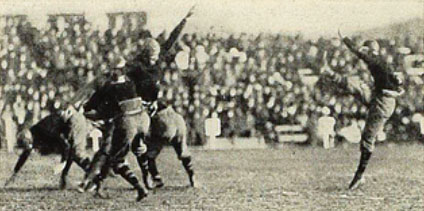
Army protects its punter vs Notre Dame. (West Point Howitzer Yearbook Class of 1914)
Notre Dame Pulls Away
The final period was all Notre Dame. The physical conditioning that Harper had stressed began to pay dividends. Jesse bragged in later years about his "iron men" not calling a single timeout in the game and using only one substitute as opposed to twelve for Army.
Notre Dame C John Voelkers recalled: "That iron man stuff was no accident. ... Harper was a stickler on condition. We had two, sometimes three scrimmages every week - rough ones. They often lasted until it was too dark to see, and always ended with wind sprints and a run to the locker room. The scrimmages were harder than the game, and longer. We were always glad when the day of the game arrived because it meant a respite from scrimmages."
Finegan dashed 25y around end, and "several bull-like rushes by Eichenlaub" resulted in a touchdown. Dorais kicked the goal. Notre Dame 21 Army 13
When the visitors got the ball back, "the forward passes began to sail around in the air again." Before Army knew what was happening, Pliska galloped to the five before several tacklers brought him down. Dorais then flipped to Joe for another six-pointer. "Dorais booted the ball over the cross-bar with graceful ease." Notre Dame 28 Army 13

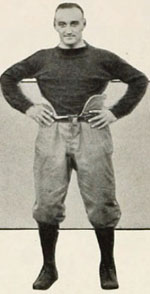
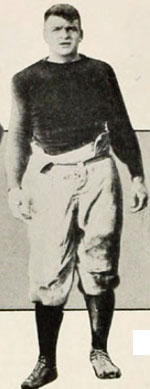

L-R: Gus Dorais, Joe Pliska, Ray Eichenlaub, Charles "Sam" Finegan
(University of Notre Dame Dome Yearbook Class of 1914)
Notre Dame's thirst for points was not quenched yet. Finegan took a pass to the Army 30, and the Cadets were penalized 15y "for off side play." ND then "began to hammer and hammer relentlessly at the tiring line of stubborn soldiers." "Fierce plunges" by Finegan and Eichenlaub slowly but surely advanced the ball to the goal line, with the big fullback plunging over. Final score: Notre Dame 35 Army 13
Cadet Dwight Eisenhower, out with an injury and serving as an undergraduate coach, sat frustrated on the Army bench throughout the game with his roommate, Omar Bradley. Both would achieve the army's highest rank, five stars, and lead the United States to victory in World War II.
Back in South Bend, the Notre Dame students crowded around the offices of the South Bend News-Times awaiting telegraph bulletins. For a long time, all they knew was the halftime score. After an agonizing delay, the final score came through. As the News-Times reported, "Pandemonium broke loose among the students. With wild shrieks of delight they turned into Main Street and in a few moments 300 had gathered to celebrate the overwhelming victory. A snake dance was quickly formed and the men invaded Michigan Street winding from curb to curb and yelling like demons."
Headlines shouted the result across the nation the next day.
NOTRE DAME'S OPEN PLAY AMAZES ARMY (New York Times)
LONG PASSES AND OPEN FIELD PLAY PROVES TOO MUCH FOR CADETS (Tulsa World)
NOTRE DAME MAKES WEST POINT ELEVEN LOOK LIKE NOVICES (Kalamazoo Gazette)
NOTRE DAME OUTCLASSES CADETS IN EVERY DEPARTMENT (Washington Evening Star)
The victors received a heroes' welcome when they returned to South Bend Monday morning. Dorais: "When we got out of our day coach at the South Bend railroad station, we found most of the town waiting for us. There was a parade with several bands and plenty of red fire, and, of course, captain Knute Rockne was called on for a speech. He made one, but he was so nervous and embarrassed that he twisted most of the buttons off his coat while he was doing it, and no one in the audience could understand a word of what he said."
Rockne would, of course, improve his speechmaking skills to the point where he perfected the inspirational pregame and halftime talks when he coached the Fighting Irish.
Postscript
According to Dwight Eisenhower, Army copied the Notre Dame passing formations to beat Navy later in the 1913 season.
Author's note: This game was so important in college football history that I fudged on my requirement for inclusion in this series. The Army coach, Charles Daly, is in the College Football Hall of Fame as a player, not a coach.
References
The Glory of Notre Dame: 22 Great Stories on Fighting Irish Football, ed. Fred Katz (1971)
Shake Down the Thunder! The Official Biography of Notre Dame’s Frank Leahy, Wells Trombly (1974)
Out of Bounds: An Anecdotal History of Notre Dame Football, Michael Bonifer and L. G. Weaver (1978)
College Football’s Most Memorable Games, 1913 Through 1990: The Stories of 54 History-Making Contests, Fred Eisenhammer and Eric B. Sondheimer (1992)
Rockne of Notre Dame: The Making of a Football Legend, Ray Robinson (1999)
Season of Saturdays: A History of College Football in 14 Games, Michael Weinreb (2014)
The Glory of Notre Dame: 22 Great Stories on Fighting Irish Football, ed. Fred Katz (1971)
Shake Down the Thunder! The Official Biography of Notre Dame’s Frank Leahy, Wells Trombly (1974)
Out of Bounds: An Anecdotal History of Notre Dame Football, Michael Bonifer and L. G. Weaver (1978)
College Football’s Most Memorable Games, 1913 Through 1990: The Stories of 54 History-Making Contests, Fred Eisenhammer and Eric B. Sondheimer (1992)
Rockne of Notre Dame: The Making of a Football Legend, Ray Robinson (1999)
Season of Saturdays: A History of College Football in 14 Games, Michael Weinreb (2014)